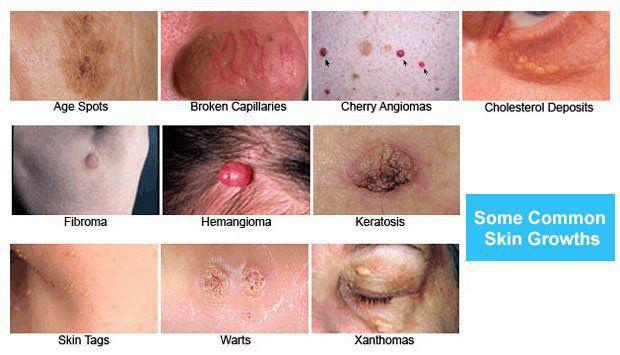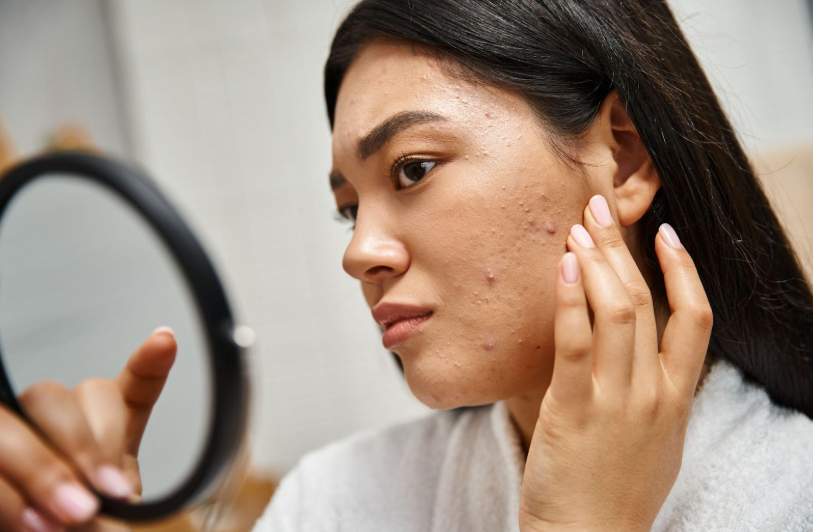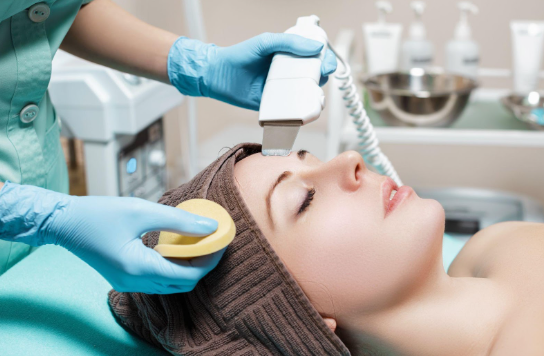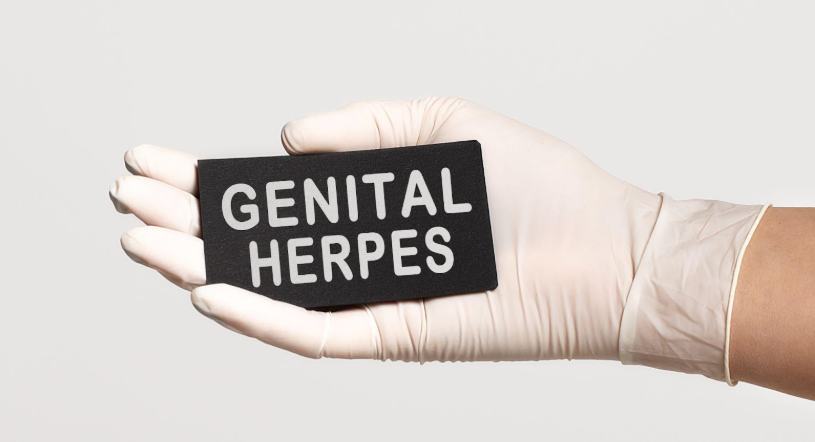Our skin serves as our body’s first line of defense against the external environment and because of this it comes into contact with, and is exposed to, all sorts of elements that can cause growths of all shapes, sizes, and behaviors to develop. Not only are there many growths that can appear on the skin but many that mimic, or are easily confused with, other skin conditions. While the causes of many of them are often poorly understood, it is known that some are associated with age, while others are inherited. Benign lesions, which are the non-cancerous kind, are not life threatening. However, many people will opt to have these benign lesions removed for cosmetic purposes. A lesion may also be removed for medical reasons if cancer, or some other disease, is suspected. Some lesions that are benign but bleed, causes pain, stay inflamed, or are constantly irritated are also often removed. I will spend a short while describing the most common skin growths that you might encounter as well as talk a bit about when you should seek dermatological care. The readers may want to see photos of the growths that I am discussing. Images of any of these conditions can be found in online medical articles. Of course, if there are any questions regarding a growth on your skin, you should schedule an appointment with myself or a colleague of mine here at Pine Belt Dermatology & Skin Cancer Center.
Some of the common skin growths you will see around Hattiesburg and Laurel, Mississippi are:
Dermatofibroma:
dermatofibromas are pink, dull red, or darkly pigmented skin lesions and often resemble a mole. This skin growths are often small, but in some cases can reach the size of a peach pit. Dermatofibromas are firm to touch and will pucker or dimple when pinched. These growths occur most often on the legs of women and can become very irritated because they can be easily nicked when shaving. Interestingly, dermatofibromas represent a scar-like reactive process that may be induced by trauma to the area, such as an insect bite. Dermatologists at Pine Belt Dermatology & Skin Cancer Center can easily remove these growths surgically or by flattening the growth by freezing – you may hear it called “cryosurgery”.
Prurigo Nodularis:
these growths appear as a thickened, rough, tumor-like, sometimes scaly lesion that often will cause intense itching. What is neat about prurigo nodularis is that it is not truly a “growth”; it is an active process that is the result of scratching, however, the exact cause of the itching remains unknown. There are a couple reasons to visit a dermatologist for these skin growths. This particular lesion can be confused with Squamous Cell Carcinoma, a type of skin cancer, so often times a skin biopsy on this lesion is necessary. Additionally, prurigo nodularis can occasionally be associated with an underlying medical condition such as eczema, kidney failure, or cancer. Lastly, treatment of these types of skin lesions can be difficult and may consist of cortisone injections directly into the growth, cortisone tapes, creams, ointments, freezing, anti-itch medication, or scraping away of the lesion.
Keratoacanthoma:
a keratoacanthoma is a fast growing, cone-shaped, flesh colored growth that is considered a variant of squamous cell carcinoma, and can sometimes be mistaken for the real thing. This growth can destroy surrounding tissue and, in rare cases, metastasize just like squamous cell carcinoma. These lesions usually develop on the skin of the extremities. This skin growth require a dermatologist’s attention because typical treatment involves surgically removing the lesion, which is then typically sent to a laboratory for microscopic examination.
Pyogenic Granuloma:
these skin growths are small pink or red lesions formed by many blood vessels. With mild trauma, these growths can bleed easily. These can appear spontaneously or develop after injury to the skin in the area. They can occur at any age and in both sexes, but tend to be more common in children. Sometimes these skin growths can form in the gums of pregnant women, but usually disappear spontaneously after delivery. When treating these, the most efficacious treatment is to surgically shave and cauterize them with an electric needle. These can also be removed surgically, cryosurgical, and/or laser surgery.
Sebaceous Cysts:
a cyst is a benign growth that forms when an inner lining or sac fills with a cheesy material. There are two types of sebaceous cysts – epidermoid and pilar. Epidermoid cysts have a central opening from which a rancid material can be expressed. If they are located in the upper layers of the skin, they may have a yellow or white appearance and have prominent overlying blood vessels. Theses cysts most commonly occur on the face, neck, and back. Pilar cysts are primarily located on the scalp. In patients with multiple lesions, inheritance can play a role in explaining why. Epidermoid cysts may arise following surgery or injury to the skin. If the cyst enlarges rapidly and ruptures, a boil-like lesion results that usually requires treatment with an antibiotic and surgical removal of the sac. It should be noted that it is easier to remove the sac when it is not inflamed. This helps in preventing infection. If a cyst begins to enlarge rapidly, becomes inflamed, breaks down, or becomes painful, it should be examined by one of our providers immediately.
Milia:
these growths can be thought of as miniature epidermoid cysts. They frequently occur on the face as single or multiple pinpoint white lesions and are common in older women. The cause of these cysts are unclear, but they may arise following injuries to the skin or from surgery. The most effective treatment is extraction, which can be performed by one of the providers at Pine Belt Dermatology.
Sebaceous Gland Hyperplasia:
these skin growths appear as small white or yellow lesions and often occur on the faces of people with oily skin. The lesions may have prominent tiny blood vessels and can resemble Basal Cell Carcinoma, the most common type of skin cancer, therefore a skin biopsy on this growth may be performed. Treatment of these growths include electrosurgery, cryosurgery, laser surgery, and photodynamic therapy.
Digital Mucinous Pseudocyst:
these lesions are bluish in color and extrude a clear, thick material when punctured. They most commonly occur in the skin overlying the base of the fingernail and can interfere with nail growth. These lesions are not true cysts, but instead represent a degenerative process of the skin in which the sticky, jelly-like substance accumulates. Treatment of these growths include cortisone injections and/or surgical removal.
Lipoma:
a lipoma is a fatty tumor that lies deep in the skin and appears as a soft lump. Occasionally, lipomas are tender to the touch but usually do not cause other symptoms. While these tumors can undergo malignant transformation, this rarely occurs. Lipomas can be small or quite large and develop in adults as single or multiple lesions. These tumors typically only require surgery when they become large and uncomfortable or exquisitely tender. The most common type of treatment is by excision.
Xanthelasma:
these growths develop on the eyelids and are yellowish or whitish in color due to lipid deposits in the skin.These growths are commonly called “cholesterol deposits”. These can occur in people who have normal lipid levels, or they can be associated with a lipid-metabolism disorder, especially high cholesterol levels. While these are benign, I would recommend coming in for a checkup. People with xanthelasma should be evaluated for elevated or abnormal cholesterol level and triglycerides. The most common treatment options include surgery, electrosurgery, cryosurgery, laser surgery, and the application of acids.
Syringoma:
these growths are small lesions of sweat gland ducts. They occur most often in women, form frequently on the lower eyelid, and are usually skin colored. The lesions also may be white. These growths tend not to hurt or itch (called “asymptomatic”). Treatments include dermabrasion, surgical removal, or laser surgery.
Trichoepithelioma:
trichoepitheliomas are small skin colored lesions that occur most commonly on the face and neck. These can sometimes resemble Basal Cell Carcinomas. The cause of these growths are not entirely understood. We do know that these lesions represent the body’s attempt to form hair follicles and shafts. In some individuals, they can become quite numerous and large and interfere with everyday function, especially if they occur in areas such as the ear canal or eye region. These growths can be removed with surgery, laser treatment, or dermabrasion.
Neurofibroma:
a neurofibroma may resemble a non-colored mole, but these growths are often very soft. These lesions are usually asymptomatic (meaning they do not hurt or itch), but they can sometimes be tender to the touch. The growths are benign and are derived from nerve sheath cells in the skin. They can be removed if a person finds them to be annoying. In instances when these growths are numerous, appear as patches of pigmentation, or freckling in the armpits, the individual may have an inherited disorder called neurofibromatosis. There are many forms of this disorder, which can be associated with brain tumors and internal neurofibromas that can become malignant. In these particular cases, patients need to be closely monitored and seek genetic counseling.
Hemangioma (Cherry Angioma):
Hemangiomas are benign growths consisting of numerous small blood vessels. The typical lesion is small, red, and appears most often on the torso of adults; however a hemangioma can develop on any area of the body. Some hemangiomas can become the size of a pencil eraser and be purple in color. People can sometimes develop hundreds of hemangiomas. These growths usually do not hurt or itch, however larger lesions may bleed and require removal. There are a number of options available for removal of these lesions, including excision, electrosurgery, and laser surgery.
Seborrheic Keratoses & Verrucous Acanthoma:
these lesions can have a wart-like appearance, and may be smooth or flat. They can range in color from skin-colored to jet black. Sometimes they have a mixture of brown and black colors, they can resemble an atypical mole or melanoma ( a lethal form of skin cancer), and it is for this reason that a biopsy may be performed on these growths. In general, seborrheic keratosis are quite common and numerous. When one of these becomes extremely large or thick, they are called verrucous acanthoma. These types of growths are frequently seen in older individuals and may be inherited. In people of color, they can often appear as small black lesions around the eyes. Lesions may be removed for cosmetic reasons or if they are associated with intense itching, bleeding, or irritation. Treatments for these growths include cryosurgery, shaving, scraping, or burning (electrodessication).
Nevi (Moles):
Moles may be pigmented or skin-colored. They arise in the pigment-producing cells (melanocytes) of the skin and can be congenital (meaning present at birth). Moles more commonly develop throughout childhood. Nevi may be flat or elevated and grow to about the size of a pencil eraser. They can develop anywhere on the body, and may disappear with time. If you or a family member has a changing mole, it may indicate that a visit to a dermatologist is necessary, as a changing mole can mean that skin cancer is developing. Any mole in question should be examined by a board certified dermatologist and may require biopsy. Moles also may need to be removed if they become irritated, or may be removed for cosmetic reasons. Remember – any mole that grows, changes in shape or color, or bleeds should prompt a visit to Pine Belt Dermatology.
Human skin can be subject to a variety of skin growths, many of which are harmless and may never require removal. Others can be precursors or indicators of a much more serious condition. To the untrained eye many of these can appear the same, which further highlights the necessity of seeking dermatological care for a skin growth that you may be worried about. Because the skin is the first line of defense you can’t be too careful when it comes to protecting it. If you have a spot that you are worried about, come see us! And in the event that you cannot find the time to get that spot looked at, click the link below to be taken to our online portal to conduct an online visit.






